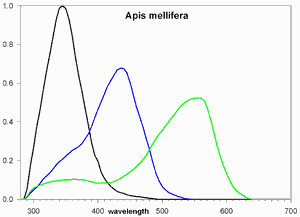
bee-wasp eye sensitivity
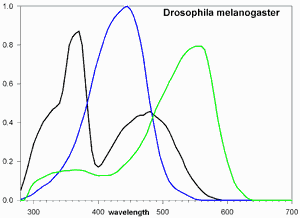
fly eye sensitivity
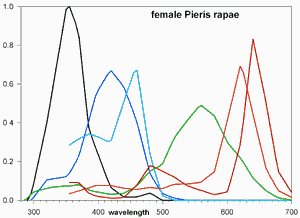
day-flying butterfly eye sensitivity
Wind pollination works well when plant biodiversity is low, but animal (biotic) pollination is best where plants of the same species are widely separated from each other. Scent and colour patterns unique to each species are used to encourage a pollinator to specialize on a species, thus maximizing the success of cross-pollination.
In Canada, most pollination of wild plants is done by bees and wasps (Hymenoptera), with flies (Diptera) close behind. Non-native honey bees (Apis mellifera) are relied on here to pollinate monoculture crops where native insects have been extirpated by pesticides, but world wide, 80% of crop pollination is carried out by native wild flies, bees and wasps.
Insects don't see light the way we do, so the visual cues they use, mostly flowers, appear different to them than to us. In particular, almost no insect except day-flying butterflies and a few beetles sees red light, but all see near ultraviolet which we can't. Most insects have only two photoreceptor types, so have little ability to discriminate colours. However those that pollinate flowering plants, such as the honey bee and fruit fly shown here, tend to have three as we do. Those few insects that can see red, flower searchers all, see four colours. The butterfly shown has six receptors; two combine to form a broad blue peak, two others to form a red one.

bee-wasp eye sensitivity | 
fly eye sensitivity | 
day-flying butterfly eye sensitivity |
So, how might we see a garden the way pollinating insects do? With ultraviolet photography.
To start, I'm using a digital camera (Nikon D90) with sensor filter removed (by LifePixel), a UV-pass filter (Baader Venus II), a UV/IR-cut filter (B+W 486) and a CoastalOpt 60mm APO Macro. Such a system doesn't see very much ultraviolet, as you can see below, but it sees enough to get started on my insect vision quest. Ultraviolet is mapped to red in the 'insect view' image so that blue and green will stay as they are to us, to maximize familiarity. Unlike many published UV photos of flowers, the brightness of each spectral segment is set equal in both human and insect views using a neutral grey card, rather than exaggerating the UV. See Bjørn Rørslett vs. mine for a comparison.
Here is the spectral sensitivity of each channel of my D90, and the result of the filters:
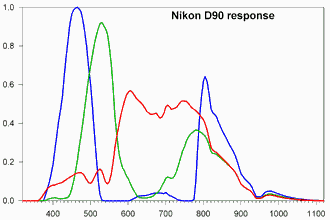
dSLR sensitivity | 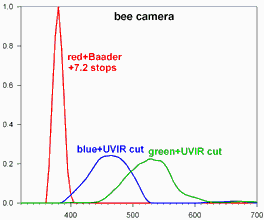
insect camera 1.0 sensitivity |
The BBC can afford optical systems that take both UV and visible images at the same time. I can't, so begin by stabilizing the flower with a stake, or picking it to put it within reach, and composing on a solid tripod. I then take one photo with a filter that passes 400-700 nm, replace that filter with one that passes only 300-400 nm, adjust exposure by 7 stops, and take the UV image; both images include a neutral grey card. The images are aligned, balanced using the neutral grey segment, then combined in Photoshop.
In many cases, yellow flowers offer disappointingly little UV difference from visible; not only do they have no pattern in UV, but the insect view is duller than what we see. In some of those cases I'm replacing UV images with microphotos, which insects also see.
A major difference between our eyes and those of insects is that while insect eyes have lower resolution than human eyes, they are much more sensitive to movements within their visual field. Our eyes are designed to separate objects in static views but insect eyes are designed to spot movement. Insects would not respond at all to still photos. We use continuous small rapid movements of our eyes (saccades) to improve recognition of edges. Insects can't, but they do occasionally make rapid flight adjustments when they need to create movement for their eyes to resolve static objects in three-dimensional surroundings.
John Sankey 2000
other notes on nature
other notes on physics
UV photography:
Bjørn Rørslett: Flowers in Ultraviolet
Insect vision:
Insect motion vision
Human factors in vision
Flowers through insect eyes
Hymenopteran colour vision
Visual pigments of Drosophila
The visual perception of 3D shape
The evolution of colour vision in insects
Evolution of colour and vision of butterflies
Coexpression of Visual Pigments in Papilio xuthus
Notes:
With all spectral plots here, the scale of each colour is chosen so that their integrals
(total intensity) are equal on each plot.
The Baader Venus II filter is the only one I've found that has sufficient IR blockage to
prevent non-UV contamination of images given the high sensitivity of CMOS sensors up to
1100 nm. It's expensive though, and 48 mm thread
only. And, since astronomers mount their filters the opposite way to cameras, the filter has to be
reversed in its mount so that the green side faces outwards.
Camerafilters.com has adaptors to standard camera sizes.
The B+W (Schneider) 486 and Baader UVIR-cut filters are the only ones I've found that have sufficient IR & UV
blockage to prevent non-visible contamination of CMOS sensor images. The B+W 486 comes in most camera sizes; it's the one I use.